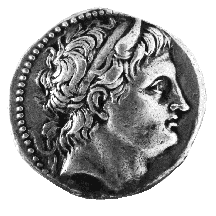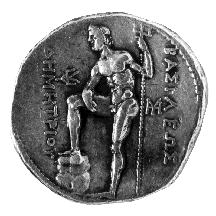



(43) Macedon, Demetrios Poliorketes - AR tetradrachm, c. 290 B.C.,
17.21 g. (inv. 91.060).
Obverse: Diademed and horned head of Demetrios r.
Reverse: Nude Poseidon standing l., with r. foot on rock,
r. arm over r. thigh, l. holding trident; monograms in l. and r. fields;
: of King Demetrios.
Provenance: Münzen und Medaillen, 1971.
Bibliography: O. Mørkholm, Early Hellenistic
Coinage from the Accession of Alexander to the Peace of Apamea (336-188
B.C.) (Cambridge 1991) 77-81.
Demetrios was the son of Antigonos Monophthalmos (the One-eyed), who assumed
control of Asia after the death of Alexander the Great. Demetrios earned
his nickname Poliorketes (Besieger) from his extensive use of siege machines
in an unsuccessful attempt to take the island of Rhodes in 305 B.C. After
their forces were defeated and Antigonos was killed at the Battle of Ipsos
in 301 B.C., Demetrios fled with a large fleet and attempted to establish
a base for his power first in Cilicia and then in Greece and Macedonia.
Like other successors of Alexander, Demetrios at first issued coins with
Alexander's types, although he quickly replaced Alexander's name with his
own and added the royal title of basileus that both he and his father
had assumed in 306 B.C. Soon he established a number of his own types, culminating
in the types for these tetradrachms, which were issued in large numbers
from c. 290 B.C. in preparation for Demetrios' invasion of Asia Minor. The
invasion ended disastrously and Demetrios was imprisoned by Seleukos; he
died in captivity in 283 B.C.
On the obverse is a youthful, idealized head of Demetrios with the royal
diadem and the horns of a bull, the animal sacred to Demetrios' patron deity,
Poseidon. With these aspects of divinity Demetrios became the first of Alexander's
successors to assimilate elements of Alexander's deified portrait (see no.
45) and the first living ruler to portray himself as a divinity on his coins.
The bull's horns were intended to suggest that he stood in the same relationship
to Poseidon as Alexander had to Zeus Ammon. The portrait is individualized,
but the upward gaze and flowing hair are meant to evoke the image of Alexander.
On the reverse is Demetrios' patron deity, Poseidon, apparently inspired
by the original of the Lateran Poseidon, a statue usually attributed to
Lysippos, the court sculptor of Alexander. Demetrios' association with Poseidon
dated to his naval victory off Cyprus in 306 B.C., after which he considered
himself lord of the sea.
K.J.B.



All contents copyright (c) 1996.
Lawrence University
All rights reserved.